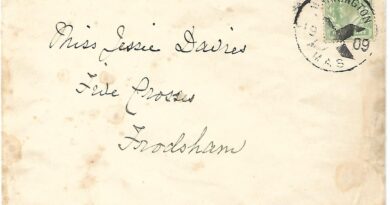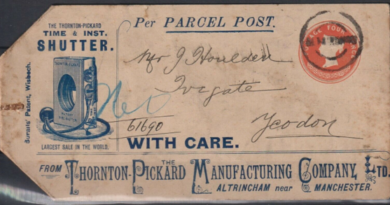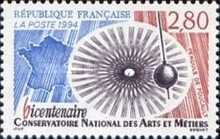COPPS outbid for British Guiana 1¢ Magenta and the Inverted Jenny block!
Preston Philatelic Society were unsuccessful in our efforts to secure the famous Guinea 1c Magenta and the US Jenny Invert block, eventually being outbid by Stanley Gibbons Ltd!
Basically, we needed more funds but increasing the annual member’s subscription might not have helped!
Details of the sale are included below.

Two unique philatelic items sold at a Sotheby’s auction on the morning of June 8th 2021: the 1918 United States Jenny Invert plate block (Scott C3a) and the 1856 British Guiana 1¢ Magenta (13).
Three legendary stamp and coin treasures belonging to shoe designer Stuart Weitzman were hammered down at Sotheby’s in New York City on Tuesday morning, June 8.
The sale, one of the swiftest in Sotheby’s history, established a new record price for a rare coin, but the realizations for the two stamp items fell shy of their presale estimates.
The 1933 $20 Double Eagle gold coin, once belonging to Egypt’s King Farouk and now unique in private hands, fetched a stratospheric $18.9 million, well beyond its $10 million to $15 million estimate and nearly double its prior auction realization.
The Inverted Jenny plate block, a unique positional multiple of the famously misprinted 1918 airmail stamp (Scott C3a), brought $4.87 million. That is well above its last auction performance in 2005, when bond trader William H. Gross purchased it anonymously for $2.97 million, but not much better than the reputed $4.5 million to $5 million that Weitzman is said to have paid its next owner, Donald Sundman of Mystic Stamp Co., in a private sale a few years later.
The block had been estimated by Sotheby’s before the sale at $5 million to $7 million.
Finishing out the banner sale was the unique and storied 1856 British Guiana 1¢ Magenta (Scott 13), dubbed “the Mona Lisa of stamps” by Sotheby’s auctioneer Richard Austin. Perhaps the toughest of the three treasures to predict a result for, it ended up going for $8.3 million, more than $1 million below the price Weitzman bid for it seven years ago at the same auction house.
While still a world record holder for any stamp or philatelic item, it fell substantially short of its presale estimate of $10 million to $15 million, and marked the first time in its long history that the 1¢ Magenta has sold for less than its previous realization.
The sale also seemed to cement the trend of recent decades in which top rare coin prices have continued to soar, while stamps have more or less plateaued.
The 1933 Double Eagle opened with a reserve bid of $7 million, which very quickly ran up to $10 million, then $12 million. There was a lengthy pause while bidders in the room contemplated their next moves. Then it continued in half-million-dollar increments as a phone bidder and a bidder in the rear of the room batted it back and forth to $16.5 million. The auctioneer remained serene, showing no desire to rush his bidders and giving them plenty of time to think about it.
“I’ll take 17 if you’d like, sir,” Austin intoned. The bidder in the room did not reply.
Eventually, the room bidder gave in and the coin was hammered for $16.75 million to the phone bidder.
Initially, Sotheby’s reported this result as totalling $19,509,750 with the buyer’s premium, which is calculated in a somewhat complicated manner as the percentage decreases with the increasing bids: 25 percent on the first $400,000, 20 percent on the amount from $400,000 to $4 million, and 13.9 percent thereafter. There are also some additional fees and charges, though sales taxes, if applicable, are not included in the reported result.
The total for the rare coin was soon officially revised to $18,872,250.
Bidding moved on to the Inverted Jenny plate block, starting at $3 million. Quickly it ran up to $3.5 million, then paused. Again, Austin seemed to be in no hurry. The bidding pace resumed, inching by $100,000 increments to $3.6 million, $3.7 million, and coming to a halt at $4 million.
Austin fished for $4.2 million, but there were no further bites, and he seemed happy to let it go for what worked out to $4,869,000 with buyer’s premium.
Finally, all eyes turned to the British Guiana 1¢ Magenta, the most enigmatic of the three items on the block. Bidding opened at $5 million and quickly ran up to $7 million with a phone bidder. As usual, the bidding paused, but this time, Austin seemed to sense instinctively that the game was up and there would be no further bids, so without further ado, he swiftly hammered it down.
The total with premium came to $8,307,000, a figure that compares disappointingly with the stamp’s last realization of $9.48 million in 2014.
Stanley Gibbons later announced that they had purchased the world’s most famous and valuable stamp.
Their stated intention is to share this with everyone, so in addition to making the stamp available for viewing at their HQ in the Strand, London, they plan to democratise the ownership of this unique item, so if you want to own your very own piece of the British Guiana 1c Magenta, you’ll have to wait for details from Stanley Gibbons.


